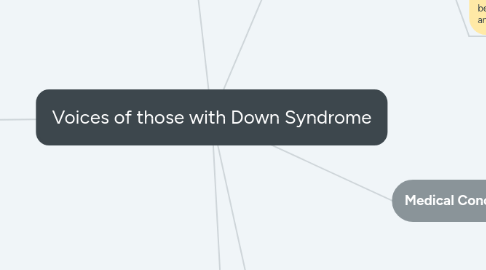
1. How their daily relationships are affected
1.1. Having Valued relationships
1.1.1. There is a difference between having 'friends' and valued relationships. Valued relationships mean there is a valued friendship that is recipricoal from both parities not just one. Many people are given social support at school however wether this continues outside of schools is different. D’Haem (2008) research identified the issue facing students with down syndrome that are given social support for school and have 'friends' but outside school have none. Becoming particularly challenging as they got older with secondary students no longer having time to keep up with scheduled meetings.
1.2. More than just social inclusion forming mutual and respectful relationships
1.3. Age appropriate relationships aswell as relationships with people of different ages
1.4. Schools peers
1.4.1. Less abusive behaviour and positive social relationships can be created from inclusive education (Thompson, Fisher, Purcal, Deeming & Sawrikar, n.d.). Thompson et al research identifies advocating of peers can enhance social interaction in inclusive settings. Students with Down Syndrome are often extroverts often thriving of positive engagement with others. Although these engagements not having for form into full valued relationships, these peer relationships would provide positive support.
2. What type of learning styles best suits them
2.1. good short memory
2.2. repetition of an activity/instruction and students often need no further explanation.
2.3. Good visual learning skills
2.4. Kinaesthetic and concrete learners
2.5. strong social skills therefore cooperative learning can work well
2.6. Individual Learning Plan (ILP)
2.6.1. Learning revolves amount specific needs of the child and these needs to be met. Purity (2011) states learning goals should be established and are given to students to achieve by a set period therefore allowing for more specifies strategies and resources to be implemented.
3. Motivating/Stimulating their interests
3.1. They have individual interests and preferences
3.2. They do not always need help to complete a task, especially if they enjoy what they do.
3.3. Baes their learning on their interest
4. Becoming Accepted
4.1. Ideology lodging for social inclusion and acceptance can be done by those with and without disabilities however the ideaology of what acceptance and inclusion looks like can vary from person to person. Although it may appear that a individual is included in various aspects of the community every individual views acceptance and inclusion differently. There is a difference between participating an having a valued role and just being present. (Dale, 2010).
4.1.1. Socially valued within the community
4.1.1.1. Attaining valued roles in the community, in order to challenge pity by others.
4.1.2. Being seen equally
4.1.2.1. Having valued roles and not being cheered on or given 'special' treatment for doing 'normal' activities that others are expected to do.

